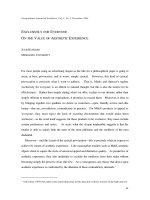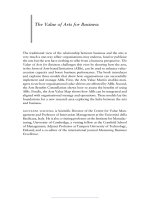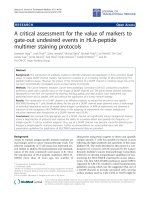The value of 18FDG PET/CT for initial staging diagnosis of breast cancer
Bạn đang xem bản rút gọn của tài liệu. Xem và tải ngay bản đầy đủ của tài liệu tại đây (88.88 KB, 6 trang )
Journal of military pharmaco-medicine n06-2018
THE VALUE OF 18FDG PET/CT FOR INITIAL STAGING
DIAGNOSIS OF BREAST CANCER
Nguyen Trong Son*; Nguyen Danh Thanh**
SUMMARY
Objectives: To determine the value of
18
FDG PET/CT in initial staging diagnosis of breast
cancer patients. Subjects and methods: 36 breast cancer patients were performed
18
FDG PET/CT
18
for initial staging diagnosis before the treatment. Results: The FDG PET/CT changed in
6/36 patients (16.7%) by T stage, in 11/36 patients (30.6%) by N stage, detected metastasis in 8
18
patients. After FDG PET/CT, 13/36 patients (36.1%) upstaged diagnosis which included 8/24
18
patients (33.3%) at stage II and 5/8 patients (62.5%) at stage III. The FDG PET/CT did not
change diagnosis in patients with clinical stage I. Conclusion:
18
FDG PET/CT scan could
effectively detect axillary and extra-axillary nodes, distant metastasis with great value in staging
diagnosis in breast cancer patients.
* Keywords: Breast cancer;
18
FDG-PET/CT; Staging diagnosis.
INTRODUCTION
Breast cancer is diagnosed based on
clinical symptoms, histology and diagnostic
imaging. Common diagnostic imaging tools
included mammography, ultrasound,
computed tomography scan (CT-scan)
and lately magnetic resonance imaging
(MRI). Early diagnosis of breast cancer in
examination periods and screening programs
has brought great value in successful
treatment.
Positron emission tomography/computed
tomography
with
flourine-1818
fluorodeoxyglucose ( FDG PET/CT)
allowed early detection of pathological
metabolism before changing anatomy and
physiology, providing important information
for accurate staging and thence, proposing
appropriate treatment regimen. The value
of 18FDG PET/CT had been demonstrated
in accurate diagnosis of tumor location,
staging progress of breast cancer, evaluating
axillary and extra-axillary lymphatic nodes
(upper and lower clavicular nodes,
internal mammary nodes). 18FDG PET/CT
also works as a significant tool in evaluating
abdominal, thoracic and bone metastasis
at the same time.
A recent research revealed that post
FDG PET/CT changed staging in 1/3
and changed first choice treatment in 1/6
of breast cancer patients [5].
18
* Vietduc Hospital
** 103 Military Hospital
Corresponding author: Nguyen Trong Son ()
Date received: 17/05/2018
Date accepted: 21/06/2018
171
Journal of military pharmaco-medicine n06-2018
In Vietnam there were about 10 nuclear
facilities over country applying PET/CT.
This contributed to improve the quality
of diagnosis and treatment for cancer
patients. A few studies were conducted
by using 18FDG PET/CT in patients with
breast cancer. However, this is not yet
a systematic, fully documented about
diagnostic value for 18FDG PET/CT. The
indication of PET/CT for which stage
of disease will be better... Therefore, the
study was carried out with the objectives:
To determine the value of 18FDG PET/CT
for staging diagnosis in breast cancer patients.
SUBJECTS AND METHODS
1. Subjects.
36 patients diagnosed with breast cancer
by histology underwent 18FDG PET/CT scan
from 2013 to 2017 in Vietduc Hospital and
Bachmai Hospital for staging diagnosis
before treatment.
Before 18FDG PET/CT, patients' staging
according to TNM classification of AJCC2010 (American Joint Committee on Cancer)
was based on clinical examinations,
CT-scan and MRI.
2. Methods.
Patients underwent whole body 18FDG
PET/CT scan. Siemens PET/CT Biograph6
system was used. 18FDG dose is 0.15
mCi/kg.
The results were analyzed by both
nuclear medicine doctor and radiologist
with CT-scan images, PET images and
overlay images combined with clinical
history and pre-scan CT and MRI images:
identified lesions with increased focus of
172
18
FDG on PET/CT. The staging of patients
was compared between pre-and post-18FDG
PET/CT scan.
RESULTS
18
Before FDG PET/CT scan, patients'
staging was based on clinical examinations,
mammography and breast ultrasound.
Most of the patients (83.1%) were diagnosed
with T1, T2 stage with tumor size < 5 cm,
without infiltration of thoracic wall and
skin, no clear clinical symptoms. Patients
with thoracic wall and skin infiltration
was 16.7%.
About 58.3% of patients was diagnosed
without axillary lymphatic nodes. According
to TNM classification, before 18FDG PET/CT
scan, 11.1% of patients were in stage I;
66.7% in stage II; 22.3% in stage III;
0% in stage IV.
Using 18FDG PET/CT, we could determine
original tumor in all 36/36 patients (100%),
tumor size range from 1.1 - 7.6 cm,
88.9% < 5 cm, medial 3.04 ± 1.52 cm.
22/36 patients (61.1%) showed axillary
lymphatic nodes (armpit and internal
mammary nodes), with 43 nodes, size
range from 0.4 - 3.1 cm; medial 1.11 ±
0.54 cm (37.2% < 1 cm; 53.5% 1 - 2 cm;
9.3% > 2 cm). Distant metastasis was
determined in 8 patients (22.2%), including
thoracic, bone, opposite breast and
axillary breast.
The 18FDG PET/CT scan changed results
in evaluating tumor infiltration (T), nodes (N)
and distant metastasis (M) compared with
pre-scan results, thus changed the overall
patients' staging.
Journal of military pharmaco-medicine n06-2018
Table 1: Change in evaluating tumor infiltration (T) after 18FDG PET/CT-scan.
Before
18
FDG PET/CT scan
After
18
FDG PET/CT scan
T
Patients
T1
T2
T3
T1
5
5
-
-
T2
25
3
19
-
3
T3
0
-
-
-
-
T4
6
-
-
-
6
Total
36
8
19
-
9
T4
Post-18FDG PET/CT-scan changed the tumor infiltration stage in 6 patients: 3 patients
changed from T2 to T1 due to tumor size; 3 patients from T2 to T4 due to thoracic wall
or skin infiltration.
Table 2: Changes in evaluating nodes (N) after 18FDG PET/CT-scan.
18
18
Before FDG PET/CT
After FDG PET/CT
N
Patients
N0
N1
N2
N3
N0
21
13
6
1
1
N1
11
1
9
-
1
N2
2
-
1
1
N3
2
-
-
-
2
Total
36
14
15
2
5
After 18 FDG PET/CT scan, results of nodes stage diagnosis changed in
11/36 patients (30.6%):
6 patients changed from N0 to N1; 1 patient changed from N0 to N2; 1 patient
changed from N0 to N3; 1 patient changed from N1 to N3 (detected another axillary
lymphatic node in opposite armpit); 1 patient changed from N2 to N3 (detected 4 axillary
lymphatic nodes, 2 in right armpit and 2 in left armpit, and mediastinum nodes);
1 patient changed from N1 to N0.
After 18FDG PET/CT scan, 8 patients were diagnosed with distant metastasis: 1 with
thoracic metastasis; 2 with bone metastasis; 2 with bone and thoracic metastasis;
1 with opposite breast metastasis; 1 with axillary breast, and 1 with both thoracic,
opposite breast and axillary breast metastasis.
173
Journal of military pharmaco-medicine n06-2018
Table 3: Changes in evaluating breast cancer stage after 18FDG PET/CT-scan.
18
Stage before PET/CT
Stage after FDG PET/CT
Stage
No. of patients
I
IIa
IIb
IIIa
IIIb
IIIc
IV
I
4
4
-
-
-
-
-
-
IIa
14
1
8
3
-
-
-
2
IIb
10
-
1
6
-
1
IIIa
0
IIIb
6
-
-
-
-
3
1
2
IIIc
2
-
-
-
-
-
-
2
IV
0
Total
36
0
0
5
9
After 18FDG PET/CT scan, 13/36 patients
had been diagnosed with increased stage
compared with pre-scan diagnosis.
5/14 patients who had pre-scan diagnosis
as stage IIa increased stage post-scan:
1 patient had axillary breast (SUVmax = 3.69),
1 patient had thoracic metastasis who
were classified as stage IV; 3 patients had
nodes and were classified as stage IIb.
3/10 patients with pre-scan diagnosis
as stage IIb increased stage post-scan:
1 patient had opposite breast metastasis
(SUVmax = 6.46) and 1 patient had multiple
bone metastasis and were classified as
stage IV; 1 patient had thoracic wall and
skin infiltration, changed from T2 to T4c,
classified as stage IIIb.
3/6 patients with pre-scan diagnosis
as stage IIIb increased stage post-scan:
1 had thoracic metastasis (SUVmax = 3.1),
1 patient had thoracic and bone metastasis
(SUVmax = 2.85 and 3.1) and were classified
174
2
9
4
1
8
as stage IV; 1 was newly detected lower
clavicular nodes (SUVmax = 5.88),
changed from N2 to N3, thus changed
from stage IIIb to IIIc.
2 patients with pre-scan classified as
stage IIIc increased stage to stage IV:
1 patient had axillary breast, thoracic and
bone metastasis; 1 patient had multiple
bone metastasis.
2/36 patients decreased stage result
after 18FDG PET/CT: 1 patient had tumor
size < 2 cm, changed from T 2 to T 1c,
therefore change from stage IIa to stage I.
1 patient changed from T2 to T1c due to
different tumor size detected between
pre- and post-scan and changed from
stage IIb to stage IIa.
There were 4 patients changed from
stage II to stage IV and 4 patients changed
from stage III to stage IV and also changed
treatment regimen (22.2%).
Journal of military pharmaco-medicine n06-2018
DISCUSSION
18
FDG PET/CT scan had great value in
diagnosing TNM stage and also helps to
categorize cancer stage. The diagnosis is
of great importance to choose appropriate
treatment for patients. Some study
showed unclear role of 18FDG PET/CT
scan in patients who had early stage
breast cancer (tumor size < 2 cm and no
clear palpated nodes). The sensitivity of
18
FDG PET/CT scan in detecting axillary
nodes was lower than sentinel node
injection technique. However, in the
patients who had inflammatory breast
cancer or local progressing breast cancer,
18
FDG PET/CT scan effectively detected
distant metastasis, especially in breast
cancer stage IIb (T2N1/T3N0) [2].
In this study, we had 4 patients with
stage I cancer who had no change in
classification after 18FDG PET/CT scan.
This result was similar to the remarks that
only patient with cancer stage II or III will
benefit from 18FDG PET/CT scan.
Garami Z, Hascsi Z [1] conducted a
study on 115 breast cancer patients who
had tumor size < 4 cm and had no
detection of distant metastasis and local
lymphatic nodes using other imaging
technique. The sensitivity in detecting
original tumor of 18FDG PET/CT scan was
93%. Nodes ultrasound scan had sensitivity
of 30% and specificity of 95% while
18
FDG PET/CT scan was 72% and 96%,
respectively. 18FDG PET/CT scan also
detected distant metastasis in 8 patients.
The result of 18FDG PET/CT scan changed
patients' stage in 54 patients (47%) and
changed treatment regimen in 18 patients
(15.6%). Furthermore, 18FDG PET/CT scan
could detect distant metastasis in 7 - 8%
patients when other imaging technique
failed.
Between progressing cancer and early
stage cancer (tumor size 2 - 3 cm; N0)
was the intermediate grade (N1, stage IIa,
IIb and T3N1 or IIIa). Most authors agreed
that 18FDG PET/CT scan had great value
in the intermediate grade. It detected
extra-axillary lymphatic nodes and hidden
distant metastasis. Groheux et al [2]
performed 18FDG PET/CT scan with
254 patients who had breast cancer over 2 cm
and stage from IIa to IIIc (based on
clinical examinations, mammography,
MRI and ultrasound). The study showed
18
FDG PET/CT scan modified cancer
stage in 77 patients (30.3%), detected
new lymphatic nodes in 40 patients
(upper and lower clavicular nodes, internal
mammary nodes) and distant metastasis
in 53 patients.
Suleman [5] investigated the role of
FDG PET/CT scan in staging breast
cancer. His study showed 18FDG PET/CT
scan had limited sensitivity in small tumor:
PET/CT sensitivity < 48% in T 1 grade
(< 2 cm), < 9% when tumor size < 1 cm
(T1a and T1b). PET/CT scan had limited
value in stage I breast cancer (N0 and tumor
size < 2 cm). These patients often underwent
operation and sentinel nodes biopsy.
18
Riedl C.C, Slobod E et al (2014) [4]
performed PET/CT scan in 134 breast
cancer patients with stage from I to IIIc
(clinical examination). The results changed
patients' stage to stage IV from I and IIa in
5% of patients, from stage IIb in 17% of
patients, from IIIa in 31% of patients and
50% of patients from stage IIIb and IIIc.
175
Journal of military pharmaco-medicine n06-2018
Krammer (2015) [3] performed PET/CT
scan in 101 patients who had T2 grade or
over or had positive nodes. PET/CT modified
nodes grade or detected metastasis in
19% of the patients, changed first choice
treatment method in 11% of the patients.
CONCLUSION
In 36 breast cancer patients, 18FDG
PET/CT scan results modified cancer grade
according to T grade in 6/36 patients
(16.7%), according to N grade in
11/36 patients (30.6%) and detected
distant metastasis in 8 patients. Cancer
stage progressed in 13/36 patients (36.1%)
including 8/24 patients (33.3%) in stage II
and 5/8 patients (62.5%) in stage III.
18
FDG PET/CT scan didn't restage breast
cancer patients with stage I.
REFERENCES
of
1. Garami Z, Hascsi Z, Varga J. The value
FDG PET/CT in early stage breast cancer
18
176
compared to traditional diagnostic modalities
with an emphasis on changes in disease
stage designation and treatment plan. The
Journal of Cancer Surgery, EJSO. 2012, 38,
pp.31-37.
2. Groheux D, Alecxandre Cochet A,
18
Olivier Humbert. F-FDG PET/CT for staging
and restaging of breast cancer. J Nucl Med.
2016, 57, pp.17-26.
3. Krammer J, Schnitzer A, Kaiser C.G.
FDG PET/CT for initial staging in breast
cancer patients is there a relevant impact on
treatment planning compared to conventional
staging modalities?. Eu Radiol. 2015, 25,
pp.2460-2469.
4. Riedl C.C, Slobod E et al. Retrospective
analysis of FDG PET/CT for staging asymptomatic
breast cancer patients younger than 40 years.
J Nucl Med. 2014, 55, pp.1578-1583.
5. Suleman Surti. Radionuclide methods
and instrumentation for breast cancer detection
and diagnosis. Semin Nucl Med. 2013, 43,
pp.271-280.









